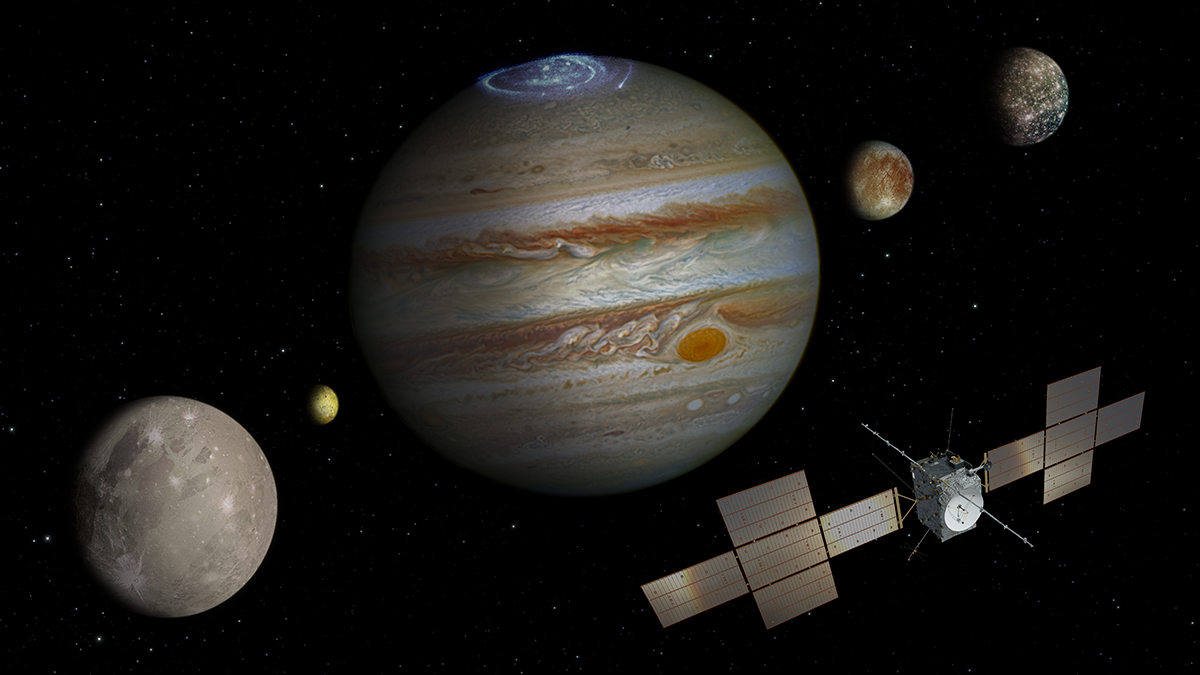
Space: extraterrestrial life, exploration of icy moons… What are the challenges of Juice’s mission?
It’s the next big space mission. This year, Airbus, ESA and Cnes will launch the Juice Test. his goal? Explore the different icy moons of giant Jupiter and find traces of life. An unprecedented science mission is scheduled to launch Thursday, April 13th.
JUICE Five letters for JUpiter ICy Moon Explorer. And it is undoubtedly the major space mission of 2023. The Juicy probe should be launched by Ariane 5 this Thursday, April 13, if the conditions are met. You must fly to Jupiter, the gas giant, a journey of about 629 million kilometers from planet Earth. Above all, you will be interested in the three icy satellites of the Jovian system in order to find, perhaps, traces of life.
Because the moons Europa, Ganymede, and Callisto are supposed to house inner oceans. The researchers hope that Joss can help answer these existential questions: “What are the conditions surrounding the formation of planets and the emergence of life, and how does the solar system function?” This was announced by the European Space Agency, ESA.
Jupiter, which is 11 times the size of our blue planet, and its 84 natural satellites — including four major moons — is a veritable “small solar system” on its own. Therefore, the giant will be studied by the Juicy probe, which will first look at its atmosphere and its magnetosphere, before turning to the three icy moons, IV, Io, as a star of fire and volcanoes.
What can be found on Europa, Ganymede and Callisto?
Therefore, it is the exploration of Europa, Ganymede and Callisto that should impress specialists. Europe (3120 km in diameter) will be carefully examined, because its ice surface covered with huge icebergs can cover an entire ocean. Especially since the Hubble Space Telescope has already noticed a release in the form of geysers of water vapor. Possible sign that water is in a liquid state.
Ganymede is the largest satellite in the solar system. We are talking here about a star with a diameter of 5200 km, larger than the planet Mercury (4880 km), and it has its own magnetic field. But it is its icy crust that excites scientists, who suspect the presence of salt water.
Finally, Callisto, also massive (4820 km in diameter), is a star without activity. Once again, the presence of ice has been credited in large quantities by astronomers who still like to ask Juice for some precious readings.
As you understand, water – necessary for life – is abundant on these three moons. It is therefore hoped that the juice will find valuable evidence of this presence, and possibly traces of microorganisms.
What is the schedule for the juice mission?
If 2023 is crucial, it is because Juice’s schedule must be respected, especially since the first plans provide for departure in 2022. But to get to Jupiter, you have to be patient. First of all, the Juice Kourou probe will depart in Guyana during the month of April. The filming window is between the thirty-fifth of this month. The probe will be launched into space by an Ariane 5 rocket.
© NASA/JPL/DLR
The juice will then position itself in a trajectory that will allow it to pick up speed around our planet, and then drift away from it before returning to it, in order to take advantage of Earth’s gravity to propel itself into space at high speed. It’s only in January 2029 that this probe will actually launch it on its journey to Jupiter. The European Space Agency reports that reaching the outskirts of Jupiter and its moons will occur in July 2031. From there until September 2035, Juice will travel through the Jovian system transmitting unpublished data of high scientific value. Perhaps the first evidence of extraterrestrial life?

“Organizer. Social media geek. General communicator. Bacon scholar. Proud pop culture trailblazer.”
